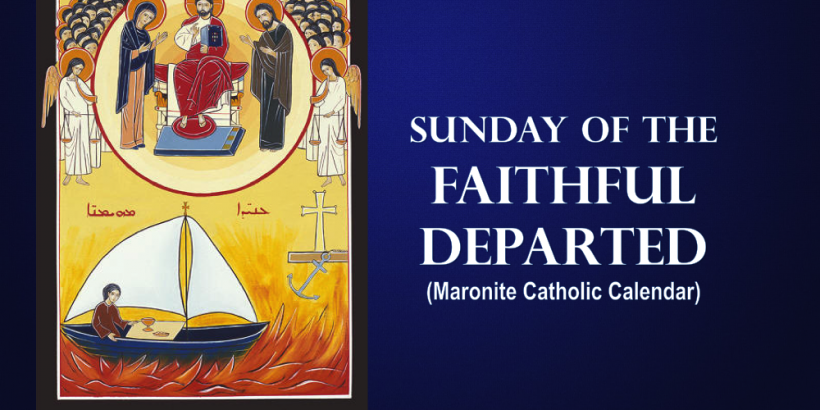Sunday of the Faithful Departed
Fr Badwi says of this icon: “The eschatological world and the last day are open for the traveller passing from our world to the true world. The faithful take the boat of salvation which is blue like the water of baptism. His viaticum is the Body and Blood of the Son of God. His direction is the anchor and the haven of salvation. His lighthouse is the Cross. He navigates through the waves of fire which will be extinguished by the fragrance of the Lord’s Body and Blood and by the waters of baptism. This icon … is inspired by the Last Judgment painting and the prayers of the Syro-Maronite liturgy.”
I would add to that the following: the icon is arranged in two registers. In the top we see the court of heaven: the Lord sits on the throne of glory, amidst his Holy Mother and His Foster-Father, who are gesturing towards Him. The Lord is clothed in red and white, perhaps pointing to the both sanctity of the martyrs who die for the faith, and the purity of those who suffer emotional pain (or passion) in patience. His feet rest on a red dais (the world of suffering), and beneath that, a stone floor (the material world).
Some of the artwork comes from the Apocalypse (the Book of Revelation). The clothing of the Lord is a white gown and a red cloak. The Lord says, in the Apocalypse, that the saints shall walk with Him in white (2:4-5; and 3:18). Behind the Lord is a brazier in which a fire is burning, reminding us of the refinement by fire of Apocalypse 3:18. Behind the brazier is the altar of heaven, for the angel of the Apocalypse fills his censer with fire from the altar (Apocalypse 8:3-5). The faithful who have been redeemed are present with the angels with horns (trumpets) to summon the world to judgment (1 Thessalonians 4:16), and balances to weigh their works (Psalm 62:9; Daniel 5:27, etc.). They are the top register.
Beneath the angel standing to the left of the altar, is a Cross standing on a plinth, and beneath that an anchor. The anchor is a symbol of hope, because it keeps the ship steady during a storm. Horizontal with the Cross are the Syriac words 3a.need m.haym.ne meaning “the faithful departed.”
Beneath those, in the lowest register, is the lake of fire which is mentioned several times in Apocalypse 19-21. This is the destination of the devil and the damned. But the Christian in the boat has the Cross at the top of the mast, and the hull is the waters of baptism. Before him are the chalice and the paten with the Eucharistic host. The boat is sailing in the direction of the Cross which is its ladder to the Court of Heaven.
The message of this icon, at its simplest, is that if we direct our lives with God as our destination, we may have hope. Our hope is fulfilled by the sacramental graces of Baptism and the Eucharist. Baptism cleanses the body and soul, preparing us for the journey, while the Eucharistic meal is our provision: the food and drink which sustain us.
But it does not end there: there is also a deeper message. This is that heaven and earth are on different levels. The reality is that both co-exist, but heaven is eternal and unchanging, while the earth is on a lower level, and is hazardous: it is a sailing on the sea of fire. One is above time, but the other is thrust into a turmoil of endless strife and change. This is symbolised, very precisely, by the two roles of fire. In heaven, the fire is confined to a brazier before the altar of God, where it serves its purpose, and is a good servant. On the earth, however, the fire is wild. It will consume everything it touches, unless there is some protection, some safeguard to keep us safe.
If anyone doubts that they are surrounded by a sea of fire, just let them try and control their thoughts and their emotions. This brings us directly from the sacraments of Baptism and the Eucharist to the spiritual life: the contemplative life and its ceaseless efforts to lift heart and mind to higher realities even while they are here on earth.
Finally, another meditation finds us as we ponder this icon: the inevitability of death. Everything we see in this world will perish. We know that the mountains will be washed away, but with our own eyes we see people going to their graves, one after the other. The greatest athletes will grow old and die or even be stricken down before they reach the mellow years. G.M. Hopkins, the great Catholic poet, wrote: “Flesh falls within sight of us, we, though our flower the same, wave with the meadow, forget that there must the sour scythe cringe, and the blear share come.” He is comparing us to grain growing in a field. We happily wave with the breezes in the meadow, and we do not think about the time when we will die, although we see many other plants being cut down by the scythe or the sharp pointed knife (the “share” is a shear, a cutter). It is a magnificent image: and an original one, although so much has already been written about death.
The ultimate message is the same as one said by a great man I knew: “Perhaps what I have to fear is not death so much as it is forgetting death.” And to this we could add: “forgetting the judgment of God which accompanies death.” It is a good day to pray for the faithful departed and to ask Our Lady to pray for us “now and at the hour of our death.” Amen.
